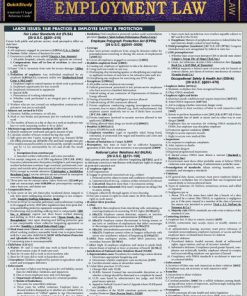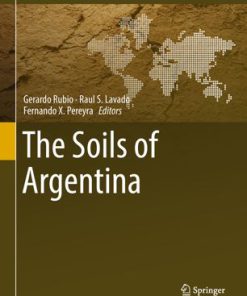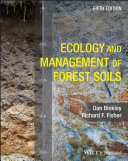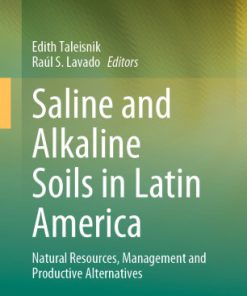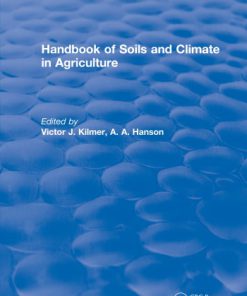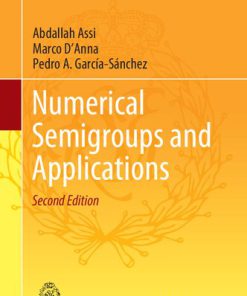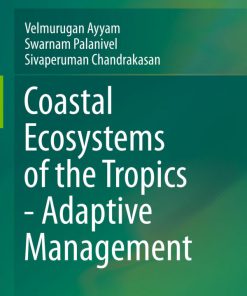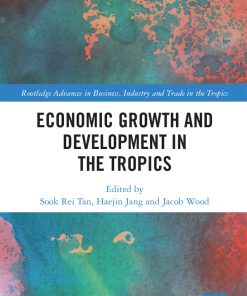Properties and Management of Soils in the Tropics 2nd Edition by Pedro Sanchez 1316814802 9781316814802
$50.00 Original price was: $50.00.$25.00Current price is: $25.00.
Properties and Management of Soils in the Tropics 2nd Edition by Pedro A. Sanchez – Ebook PDF Instant Download/DeliveryISBN: 1316814802, 9781316814802
Full download Properties and Management of Soils in the Tropics 2nd Edition after payment.
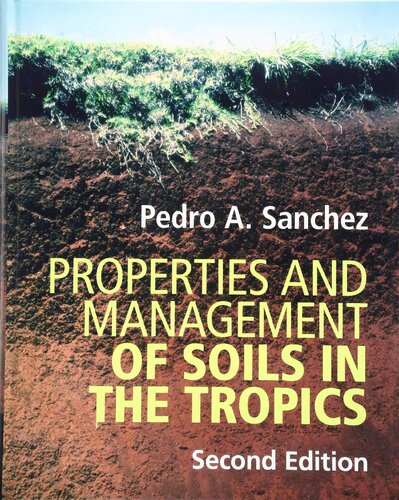
Product details:
ISBN-10 : 1316814802
ISBN-13 : 9781316814802
Author: Pedro A. Sanchez
The long-awaited second edition of this classic textbook expands on the first edition to include advances made in the last four decades, bringing the topic completely up to date. The book addresses critical issues such as whether humanity can feed itself, and whether it can do so in environmentally sound and sustainable ways. Written from agronomic, environmental, and ecological standpoints, the textbook employs a multidisciplinary approach, including policymaking and plant genetic improvements, as well as ecosystem services, climate change, biodiversity, sustainability and resilience. New chapters in this second edition focus on organic carbon in soil, soil biology, soils in relation to livestock production and forestry, and agroforestry. The new edition will again be the go-to textbook for courses on tropical soils, and a reference textbook for soil and agricultural scientists and development professionals working in the tropics.
Properties and Management of Soils in the Tropics 2nd Table of contents:
Part I The Tropical Environment
Chapter 1 The Natural Environment of the Tropics
1.1 The Tropics Defined
1.2 Temperature and Solar Radiation
1.2.1 Temperature
1.2.2 Solar Radiation
1.2.3 Photoperiod
1.3 Rainfall
1.3.1 Intertropical Convergence Zone
1.3.2 Monsoons
1.3.3 El Niño Southern Oscillation
1.3.4 Moisture Availability Index
1.3.5 Rainfall Intensity
1.3.6 Soil Moisture
1.4 Tropical Climates
1.4.1 Subhumid Tropics
1.4.2 Humid Tropics
1.4.3 Semiarid Tropics
1.4.4 Arid Tropics
1.5 Vegetation
1.5.1 Savannas
1.5.2 Humid Tropical Forests
1.5.3 Semiarid Vegetation
1.5.4 Deserts
1.5.5 Net Primary Productivity
1.6 Physiography
1.6.1 Tropical America
1.6.2 Tropical Africa
1.6.3 Tropical Asia and the Pacific
1.7 The Anthropocene
1.8 Biodiversity in the Tropics
1.9 Climate Change
1.9.1 Impacts
1.9.2 Adaptation to Climate Change
1.9.3 Mitigating Climate Change
1.9.4 An Unwitting Case of Mitigation
1.10 Summary and Conclusions
References
Chapter 2 The Human Environment of the Tropics
2.1 Demographics
2.1.1 Population Growth
2.1.2 Human Fertility
2.1.3 Small Farms Predominate
2.1.4 Urbanization and Changing Demands for Agriculture
2.2 Key Concepts
2.2.1 Food Security
2.2.2 Nutrition Security
2.2.3 Food Systems
2.2.4 Food-Value Chain
2.2.5 Sustainability
2.3 The Fight Against Hunger and Absolute Poverty
2.3.1 Hunger
2.3.2 Health
2.3.3 Absolute Poverty
2.3.4 The Millennium Development Goals
2.3.5 The Sustainable Development Goals
2.4 The Food Versus Population Race
2.5 Green Revolutions
2.5.1 The Asian Green Revolution: The Big Ratchet
2.5.2 The Ones Who Didnt Benefit
2.5.3 The Pivot (Changing Point)
2.6 Tropical Agroecosystems
2.6.1 The Database
2.7 Land Use and Land-Use Change
2.8 Intensification and Extensification
2.8.1 Intensification: The U-Shaped Curve
2.8.2 Extensification
2.9 Summary and Conclusions
References
Part II Pedology, Physics, Chemistry and Biology
Chapter 3 History of Soil Science in the Tropics
3.1 The Laterite Paradigm
3.2 Tropical Soils Are Very Diverse
3.3 Tropical Soil Research: 1970s to 1990s
3.4 The First Soil Management Paradigm
3.5 The Second Soil Management Paradigm
3.6 The Third Soil Management Paradigm
3.7 Soils in a Global Context
3.7.1 Soil Health and Soil Quality
3.7.2 Degraded Soils
3.7.3 Fragile Ecosystems and Fragile Soils
3.7.4 Core Soil Properties
3.8 Summary and Conclusions
References
Chapter 4 Soils of the Tropics
4.1 Soil Taxonomy
4.2 World Reference Base for Soil Resources
4.3 A National Soil Classification System: Cuba
4.4 Main Soils of the Tropics
4.4.1 Oxisols (962 million hectares)
4.4.2 Ultisols (760 million hectares)
4.4.3 Inceptisols (606 million hectares)
4.4.4 Entisols (603 million hectares)
4.4.5 Alfisols (480 million hectares)
4.4.6 Aridisols (186 million hectares)
4.4.7 Vertisols (150 million hectares)
4.4.8 Andisols (45 million hectares)
4.4.9 Mollisols (36 million hectares)
4.4.10 Histosols (32 million ha)
4.4.11 Spodosols (6 million hectares)
4.4.12 Gelisols
4.5 Soils at the Landscape Scale
4.5.1 Udic Environments
4.5.2 Ustic Environments
4.5.3 Tropical Highlands
4.5.4 Tropical Deserts
4.5.5 Tropical Alluvial Plains and Deltas
4.6 Importance of Soil Diversity to Ecologists and Modelers
4.7 Summary and Conclusions
References
Chapter 5 Functional Capability Classification
5.1 System Structure and Definitions
5.2 Areal Extent of FCC Attributes
5.3 Attributes Related to Soil Mineralogy
5.3.1 Low Nutrient Capital Reserves (k)
5.3.2 High Leaching Potential (e)
5.3.3 High Phosphorus Sorption by Iron (i)
5.3.4 Subsoil Anion Exchange Capacity (q)
5.3.5 Volcanic Soils (x)
5.3.6 Cracking Clays (v)
5.4 Attributes Related to Soil Organic Matter
5.4.1 High Organic Carbon Content (O type)
5.4.2 Low Organic Carbon Saturation (m)
5.4.3 Low Active Carbon (f)
5.5 Attributes Related to Soil Physical Properties
5.5.1 Shallow Depth (R type)
5.5.2 Poorly Drained Soils (g and g+)
5.5.3 Drought Stress (d and d+)
5.5.4 Cold Soils (t and t+)
5.5.5 Gravel (r+, r++, r+++)
5.5.6 Slope (percent)
5.5.7 High Erosion Risk (y)
5.5.8 Surface Sealing (z)
5.6 Attributes Related to Soil Reaction (pH)
5.6.1 Sulfidic Soils (c)
5.6.2 Aluminum Toxicity (a)
5.6.3 Calcareous Soils (b)
5.6.4 Saline Soils (s)
5.6.5 Sodic Soils (n)
5.7 Regional Differences
5.8 Interpreting FCC Classes
5.9 Actual and Potential Use of FCC
5.10 Summary and Conclusions
References
Chapter 6 Soil Physical Properties
6.1 Depth of Rooting
6.2 Soil Temperature
6.2.1 Controlling Excessively High Soil Temperatures
6.2.2 Controlling Low Soil Temperatures
6.3 Soil Structure
6.3.1 Aggregate Formation
6.3.2 Aggregate Destruction
6.3.3 Influence of the Three Core Factors
6.3.4 Measuring Soil Structure
6.3.5 Structure of Major Soils of the Tropics
6.3.6 Changes with Tillage
6.4 Soil Compaction
6.4.1 Surface Sealing and Crusting
6.4.2 Hardsetting
6.4.3 Plow Pans
6.4.4 Managing Soil Compaction
6.5 Soil Water
6.5.1 Soil Water Retention
6.5.2 Water-Holding Capacity
6.5.3 Leaching
6.5.4 Runoff
6.6 Soil Erosion
6.6.1 Rainfall Erosivity (R)
6.6.2 Soil Erodibility (K)
6.6.3 Slope Length and Gradient (LS)
6.6.4 Vegetative Cover (C)
6.6.5 Protective Structures (P)
6.6.6 Measuring Soil Erosion
6.6.7 Civil Engineering Erosion
6.7 Soil and Water Conservation Practices
6.7.1 Small-Scale Structures in the Field
6.7.2 Contour Cultivation
6.7.3 Contour Hedges
6.7.4 Earth Terraces
6.7.5 Stone Bench Terraces
6.7.6 Stone Bunds
6.7.7 Rehabilitating Eroded Landscapes by Community Action
6.7.8 Controlling Gully Erosion
6.7.9 Runoff Storage in the Subsoil
6.8 Conservation Agriculture
6.8.1 Principles of Conservation Agriculture
Crop Yield Decrease
Increases in SOC
Control of Runoff and Erosion
Better Water Provision
Soil Compaction
Climate Regulation
6.8.2 Soils in Which Conservation Agriculture Works
Oxisols, Andisols, Nitisols, Oxic Groups of Ultisols and Alfisols (Ci, Lx Soils in the FCC system),
Loamy, Gravelly Alfisols (LCr+, SL, LC soils)
Entisols and Inceptisols of the Indo-Gangetic Plain
Loamy and Clayey Alfisols – The Zambian Model
6.8.3 Soils in Which Conservation Agriculture is Difficult
Wet Soils (g Soils)
Vertic Soils (v Soils)
Structurally Inert Soils (SLz Soils)
Mounds for Root Crops
6.8.4 Small-Scale Farms in Africa
6.9 Summary and Conclusions
References
Chapter 7 Water
7.1 Overall Perspective
7.1.1 Green Water and Blue Water
7.1.2 Water Scarcity
7.1.3 Water Requirements to Feed the World
7.2 Metrics
7.2.1 Water Productivity: Fewer Drops per Crop
7.2.2 Water Use Efficiency: Crop per Drop
7.3 Rainfed Agriculture
7.3.1 Going from 1 to 3 t/ha: The Green Revolution Bonus
7.3.2 Rainfall Variability
7.3.3 Time of Planting in Rainfed Agriculture
7.3.4 Droughts
7.3.5 Dry Spells
7.4 Irrigated Agriculture
7.4.1 Large-Scale Basin Irrigation
7.4.2 Irrigation Efficiency
7.4.3 Furrow or Flood Irrigation
Land Leveling
Appropriate Rates of Fertilizer
7.4.4 Sprinkler Systems
7.4.5 Low-Pressure Center-Pivot Systems
7.4.6 Drip Irrigation
7.4.7 Treadle Pumps
7.5 Irrigation and Carbon
7.6 Perspectives
7.7 Summary and Conclusions
References
Chapter 8 Mineralogy
8.1 Basic Concepts
8.2 Paradigm Shifts
8.3 Types of Clay Minerals
8.3.1 Permanent-Charge Clay Minerals
8.3.2 Variable-Charge Clay Minerals
8.3.3 SOM
8.4 Mineralogy Families
8.5 Measurement Issues
8.6 pH-Charge Relationships
8.6.1 Delta pH
8.6.2 pH-Charge Relationships
8.6.3 The pH at the Zero Point of Charge (pH0)
SOM
Specific Anion Adsorption
8.6.4 Is Increasing ECEC Always Beneficial?
8.7 Anion Exchange Capacity: An Asset of the Tropics
8.8 Summary and Conclusions
References
Chapter 9 Soil Acidity
9.1 Causes of Soil Acidity
9.1.1 pH Determination
9.1.2 Exchangeable H+
9.1.3 Exchangeable Al3+
9.1.4 Aluminum Saturation
9.1.5 Aluminum in the Soil Solution
9.1.6 Buffering Capacity
9.1.7 Non-Exchangeable Acidity
9.1.8 Potentially Reactive Aluminum Pool
9.1.9 Distribution of Acid Soils
9.2 Acid Soil Infertility
9.2.1 Aluminum Toxicity
9.2.2 Calcium Deficiency
9.2.3 Magnesium Deficiency
9.2.4 Manganese Toxicity
9.2.5 Molybdenum Deficiency
9.2.6 Effects of Soil Biota
9.3 Genetic Differences in Aluminum Tolerance
9.3.1 Species Differences
9.3.2 Aluminum Tolerance
9.4 Liming
9.4.1 Lime Requirement
9.4.2 The Brazil V Method
9.4.3 Quality of Lime
9.4.4 Lime Placement
9.4.5 Adjusting for Aluminum Tolerance
9.4.6 Liming with Kitchen Ash
9.4.7 Liming with Organic Inputs?
9.5 Overliming
9.6 Residual Effects of Liming
9.7 Subsoil Acidity
9.8 Secondary Acidity
9.9 Advantages of Acid Soils
9.10 Summary and Conclusions
References
Chapter 10 Soil Biology
10.1 Definitions
10.2 Soil Biodiversity
10.3 Ecosystem Functions and Services
10.4 Comminution
10.5 Decomposition
10.6 Transformation of Nutrient Elements
10.7 Soil Structure Regulation
10.7.1 Termites
10.7.2 Earthworms
Burrowing and Cast Building
Effects on Physical Soil Properties
Effects on SOM and Soil Fertility
Effects of Earthworm Inoculations in Agriculture
How About Vermicomposting?
10.8 The Root Extenders: Mycorrhizae
10.8.1 Ectomycorrhizae
10.8.2 Endomycorrhizae
10.8.3 Positive and Negative Effects
10.8.4 Inoculation at the Field Scale
10.8.5 Inoculation at the Nursery Scale
10.9 Soil Biodiversity and Land-Use Change
10.9.1 Humid Tropics
10.9.2 Subhumid and Semiarid Tropics
10.10 Reflections
10.11 Summary and Conclusions
References
Chapter 11 Organic Carbon
11.1 History of SOC Research
11.2 Tropical Soils and the Global Carbon Cycle
11.2.1 The Global Carbon Cycle
11.2.2 Tropical SOC and the ”Missing Terrestrial Carbon Sink”
11.2.3 Topsoil Organic Carbon
11.2.4 Subsoil Organic Carbon
11.3 SOC in Tropical and Temperate Regions
11.4 Carbon Pools and Fractions
11.4.1 Organic Resources and Metabolic and Structural Pools
11.4.2 The Active SOC Pool
11.4.3 The Slow and Passive SOC Pools
11.5 Carbon Sequestration
11.5.1 The Carbon Sequestration Process
11.5.2 Determinants of Aggregate Formation and Stabilization
11.5.3 Determinants of Aggregate Destabilization
Soil Temperature
Alternate Wetting and Drying
Tillage
Bioturbation
11.5.4 Carbon Sequestration Rates
11.5.5 Carbon Saturation
11.5.6 Carbon Release
11.5.7 Deep SOC Sequestration
11.5.8 Conclusion and Uncertainties
11.6 Animal Manures
11.6.1 Nutrient Composition
11.6.2 Manure Quality
11.6.3 Manure Transformations: From Cow to Crop
11.6.4 Manure Efficiency
11.6.5 Does Manure promote Carbon Sequestration?
11.6.6 Improvements in Soil Physical Properties
11.7 Composts
11.8 Biochars
11.8.1 Structure of Biochars
Organic Carbon
Ash
11.8.2 Effects of Biochars on Soil Properties and Crop Yields
Instantaneous Sequestration of Carbon
Can biochar applications increase crop yields?
Increased Soil Water Retention
Reduced Soil Acidity
Increased Nutrient Availability
Pore Size, Decomposition Rates and Soil Charge
More uncertainties
Conclusions
11.9 Organic Farming
11.9.1 The Science of Organic Farming
Nutrients
Pests
Human Nutrition and Health
Environment
The Transition from Conventional to Organic Farming
Implications for the Tropics
Cuba
11.9.2 Crop Yield Comparisons between Conventional and Organic Agriculture
11.9.3 The Rhetoric Around Organic Farming
11.9.4 Organic Farming is Different From Agroecology and ”Sustainable Agriculture”
11.9.5 Can Organic Farming Feed the World?
11.10 Summary and Conclusions
References
Part III Soil Fertility
Chapter 12 Soil Fertility Principles
12.1 The Law of the Minimum
12.2 Synchrony
12.3 Nutrient Cycling
12.4 Nutrient Uptake by Crops and Cycling
12.5 Determining Fertilizer Needs
12.5.1 Soil Sampling
12.5.2 Tackling Soil Variability
12.5.3 Laboratory Analysis
12.5.4 Soil Test Correlation
12.5.5 Curvilinear Models
12.5.6 The Linear Response and Plateau Model
12.6 Early Twenty-First-Century Paradigm Shifts
12.6.1 Spectrometry
12.6.2 Digital Soil Mapping
12.6.3 Bringing the Laboratory to the Field
12.7 Summary and Conclusions
References
Chapter 13 Nitrogen
13.1 The Nitrogen Cycle
13.2 Nitrogen Pools and Fractions
13.3 Atmospheric Deposition
13.4 Biological Nitrogen Fixation
13.4.1 Rhizobia-Legume Symbiosis
13.4.2 Cyanobacterial Symbiosis
13.4.3 Frankia Symbiosis
13.4.4 Free-Living Bacteria
13.4.5 Endophytic Bacteria
13.4.6 Inoculation
13.4.7 Amounts Fixed
Rhizobia
Frankia-Casuarina symbiosis
Free-Living Bacteria in the Rhizosphere
Azolla
Endophytic Nitrogen Fixation
13.4.8 Transfer of Fixed Nitrogen to Other Plants
13.4.9 Overall Contribution of Biological Nitrogen Fixation to Food Production
13.5 Mineral Fertilizers
13.5.1 The Haber-Bosch Ammonia Synthesis
13.5.2 Nitrogen Fertilizers
13.5.3 Green Revolution Germplasm
13.5.4 Nitrogen Fertilizer Sources
13.5.5 Rates of Application
13.5.6 Fertilizer Placement
13.5.7 Timing of Applications
13.6 Organic Nitrogen Mineralization
13.6.1 SON Pools and Nitrogen Mineralization
13.6.2 Immobilization
13.6.3 Influence of the Core Properties
13.7 Nitrogen Fertilizer Reactions in Soils
13.7.1 Urea Hydrolysis
13.7.2 Ammonia Volatilization
13.7.3 Ammonium Fixation
13.7.4 Immobilization of Fertilizer NH4+ and NO3-
13.8 Fluctuations of Inorganic Nitrogen
13.8.1 Nitrate Accumulation during the Dry Season
13.8.2 The Birch Effect: Nitrogen Flushes at the Onset of the Rainy Season
13.8.3 Downward Nitrate Movement During the Rainy Season
13.9 Combining Mineral and Organic Nitrogen Fertilizers
13.9.1 Classifying Organic Fertilizers
13.9.2 Importance of Knowing Nutrient Composition
13.9.3 Dynamics of Mineral and Organic Fertilizers with Time
13.10 Environmental Consequences
13.10.1 Can Mineral Fertilizers Increase SOC?
Increasing the Annual Amount of Fresh Organic Inputs (b)
Changing the Decomposition Rate of Organic Inputs (m) with fertilization
Decreasing the SOC Decomposition Rate (k)
Overall Effects
13.10.2 Denitrification, NH3, NO and N2O Emissions
DNRA and Anammox
Nitric Oxide
Nitrous Oxide
The Three Core Soil Properties
13.10.3 Leaching to Groundwater
13.11 Efficiency of Nitrogen Fertilization
13.11.1 Nitrogen Use Efficiency
13.11.2 Agronomic Efficiency
13.11.3 Fertilizer Recovery
13.11.4 Physiological Efficiency
13.12 Profitability
13.13 Summary and Conclusions
References
Chapter 14 Phosphorus
14.1 The Phosphorus Cycle
14.1.1 The Phosphorus Cycle at the Geologic Time Scale
14.1.2 The Phosphorus Cycle at a Human Time Scale
14.1.3 Will the World Run Out of Phosphorus?
14.2 Total Soil Phosphorus
14.3 Inorganic Phosphorus
14.3.1 Primary Minerals
14.3.2 Secondary Minerals
14.3.3 Sorbed Phosphorus and Available Phosphorus
14.3.4 Soil Solution Phosphorus
14.4 Organic Phosphorus
14.4.1 Composition
14.4.2 The Hedley Fractionation
14.4.3 Organic Inputs, Metabolic and Structural Phosphorus Fractions
14.4.4 Active SOP Fraction
14.4.5 Slow and Passive SOP Fractions
14.5 Phosphorus Sorption and Release
14.5.1 Precipitation from the Dissolution of Phosphorus Fertilizers
14.5.2 Adsorption
14.5.3 Absorption
14.5.4 Estimating Phosphorus Sorption in the Laboratory
14.5.5 Proposed New Limit for Soils with High Phosphorus Sorption Capacity
14.5.6 Estimating High Phosphorus Sorption in the Field
14.5.7 Geographical Distribution of Soils with a High Phosphorus Sorption Capacity
14.5.8 Influence of the Core Soil Properties on Phosphorus Sorption
Texture
Mineralogy
SOM
14.5.9 Ways to Decrease Phosphorus Sorption
Liming
Silicate Applications
Organic Inputs
14.5.10 Phosphorus Release
14.6 Soil Tests for Available Phosphorus
14.7 Plant Phosphorus Requirements
14.7.1 External and Internal Phosphorus Requirements
14.7.2 Genotype Adaptation to Low Available Phosphorus
14.7.3 Effective Root Volume
14.7.4 Rhizosphere Exudation
14.8 Phosphorus Fertilization
14.8.1 Phosphorus Fertilizers
14.8.2 Phosphate Rocks
14.8.3 Managing Phosphorus Fertilizers in Low Phosphorus Sorption Soils
14.8.4 Managing Soluble Fertilizers in Soils with High Phosphorus Sorption Capacity
14.8.5 Managing Direct Applications of Phosphate Rock
14.8.6 Brazilian Strategies for Managing Phosphorus Applications in Soils with High Phosphorus Sorpt
14.8.7 East African Strategies for Managing Phosphorus Applications in Soils with High Phosphorus So
14.9 Residual Effects and Efficiency of Utilization
14.9.1 Phosphorus Balance Studies
14.9.2 Increasing Phosphorus Use Efficiency and Decreasing Environmental Damage
14.10 Summary and Conclusions
References
Chapter 15 Sulfur
15.1 The Sulfur Cycle
15.1.1 Sources of Soil Sulfur
15.1.2 Total Sulfur
15.1.3 Organic Sulfur
15.1.4 Mineralization
15.1.5 Inorganic Sulfur
15.1.6 Plant Uptake
15.1.7 Changes with Cultivation
15.1.8 Acid Sulfate Soils
15.2 Sulfur Sorption
15.2.1 Anion Exchange
15.2.2 Sorption
15.3 Crop Requirements
15.4 Nutrition
15.4.1 Sulfur Fertilization
15.5 Soil Testing
15.6 Sulfur Fertilization
15.6.1 Sources
15.6.2 Rates
15.6.3 Timing and Placement
15.6.4 Agronomic Efficiency and Fertilizer Recovery
15.7 Summary and Conclusions
References
Part IV Management Systems
Chapter 16 Soils and Slash-and-Burn Agriculture
16.1 Shifting Cultivation and Slash-and-Burn Agriculture
16.1.1 Traditional Shifting Cultivation
16.1.2 Slash-and-Burn Agriculture
16.2 Forest-Soil Nutrient Cycles
16.2.1 Carbon and Nutrient Stocks in the Vegetation
Leaves
Roots
16.2.2 Carbon and Nutrient Stocks in the Soil
16.2.3 Nutrient Fluxes from the Vegetation to the Soil
Rainwash
Litter fall
Fallen Timber
Roots
16.2.4 Nutrient Fluxes from the Atmosphere to the Soil
Rain and Dust
Biological Nitrogen Fixation
16.2.5 Nutrient Losses from Soils
Runoff and Erosion
Leaching
Nitrous Oxide Emissions
16.2.6 The Cycle as a Whole
16.3 Land Clearing by Slash and Burn
16.3.1 Temperature and Solar Radiation
16.3.2 Nutrient Additions by the Ash
Dry Mass
Nitrogen
Phosphorus
Potassium, Calcium and Magnesium
Sulfur
Micronutrients
Overall Considerations
16.3.3 Changes in Soil Chemical Properties upon Clearing and Burning
Soil pH, Exchangeable Cations and Aluminum Saturation
Effective Cation Exchange Capacity
Phosphorus
16.3.4 Changes in Biological Soil Properties upon Clearing and Burning
SOC
Total Nitrogen
Microbial Activity
Nitrogen Mineralization
16.3.5 Changes in Soil Physical Properties upon Clearing and Burning
Soil Structure, Runoff and Erosion
Hydrological Consequences
16.4 Mechanized Land Clearing
16.4.1 No Burning, No Ash
16.4.2 Topsoil Displacement
16.4.3 Soil Compaction and Lower Infiltration Rates
16.4.4 Increased Runoff and Erosion
16.4.5 Crop Yields after Mechanical Clearing
16.4.6 A Personal Story
16.4.7 Can Mechanized Land Clearing be Improved?
16.4.8 Costs
16.4.9 Policy
16.5 Crop Yield Declines and Field Abandonment
16.5.1 Soil Fertility Decline
16.5.2 Increased Weed Infestation
16.5.3 Deterioration of Soil Physical Properties
16.5.4 Increasing Incidence of Pests and Diseases
16.5.5 Shortened Fallows
16.5.6 Social Customs
16.6 Secondary Forest Fallows
16.6.1 Biomass Regrowth
16.6.2 Nutrient Accumulation in the Biomass
16.6.3 Soil Nutrient Dynamics
16.6.4 Early Succession Stage (0 to 2-4 years)
16.6.5 The Fallow Enrichment Stage (after canopy closure), 4 to 18+ Years
16.7 Alternatives to Slash and Burn
16.7.1 Managed Forests
Forest Reserves
Selective Logging by Smallholders
Extractive Reserves
Community-Managed Forests
16.7.2 Complex Agroforests
Jungle Rubber in Indonesia
Multistrata Agroforests in the Peruvian Amazon
Damar Complex Agroforests in Indonesia
Commercial Complex Agroforests in RECA, Rondônia, Brazil.
16.7.3 Simple Agroforests
16.7.4 Improved Pastures after Slash and Burn
Pioneer Pastures
Degraded Pastures
Improved Pastures
16.7.5 Continuous Crop Cultivation
The Yurimaguas Continuous Cultivation Experiment
What about Oxisols?
The Catastrophic School Strikes Back
Soybeans in the Brazilian Amazon
16.8 Combining Agricultural Intensification with Decreased Deforestation
16.9 Summary and Conclusions
References
Chapter 17 Soil Management in Rice Cultivation
17.1 Physical Consequences of Flooding
17.1.1 Swelling
17.1.2 Permeability
17.1.3 Aggregate Stability
17.2 Puddling
17.2.1 Aggregate Destruction
17.2.2 Changes in Porosity
17.2.3 Changes in Bulk Density
17.2.4 Increased Soil Moisture Retention
17.2.5 Agronomic Advantages
17.2.6 Chemical Reduction
17.2.7 Regeneration of the Structure
17.2.8 Effects on Rice Yields
17.3 Chemical and Biological Consequences of Flooding
17.3.1 Biota in the Flooded Soil
17.3.2 Volume of the Soil Solution
17.3.3 Temperature
17.3.4 The Reduction Process
17.3.5 Oxidized and Reduced Zones in Flooded Soils
17.3.6 Changes in pH
17.3.7 Nitrogen Transformations
Gain Processes
Loss Processes
Intermittent Flooding
17.3.8 Manganese Transformations
17.3.9 Iron Transformations
17.3.10 Phosphorus Availability
17.3.11 Sulfur Transformations
17.3.12 Non-reducible Cations
17.3.13 Zinc
17.3.14 Silicon
17.3.15 Salinity
17.3.16 Reversibility
17.4 Rice Cultivation Systems
17.4.1 Irrigated Lowland Rice
17.4.2 Rainfed Lowland Rice
17.4.3 Irrigated Lowland Rice in Rotation with Aerobic Crops
17.4.4 Directly Seeded Irrigated Lowland Rice
17.4.5 Flood-Prone Rice
17.4.6 Upland Rice
17.4.7 Modern Rice Varieties: The Game Changer
17.5 Water
17.5.1 Adaptation of the Rice Plant to Flooded Conditions
17.5.2 Water-Stress Susceptibility
17.5.3 Effects of Flooding on Yields
17.5.4 Water Requirements for Lowland Rice Cultivation
17.5.5 Water-Saving Options
Water Saturation Without Flooding
Alternate Wetting and Drying
Aerobic Rice
From Transplanting to Direct Seeding
17.5.6 SRI: System of Rice Intensification
17.5.7 Puddling Remains
17.6 Nutrient Management
17.6.1 Plant Type and Solar Radiation
17.6.2 Principles of Site-Specific Nutrient Management
17.6.3 Indigenous Soil Nutrient Supplies
17.6.4 Estimating the Nitrogen Fertilizer Rate
Source and Placement of the Selected Nitrogen Rate
17.6.5 Flexible Timing of Nitrogen Applications
17.6.6 Phosphorus
17.6.7 Potassium
17.6.8 Assessing the SSNM Approach
17.6.9 Other Nutrients
People also search for Properties and Management of Soils in the Tropics 2nd:
properties of topsoil
tropical soil profile
soils associated with tropical climates are called
biological properties of soil apes
biological properties of soil
Tags: Properties, Management, Soils, the Tropics, Pedro Sanchez
You may also like…
Jurisprudence & Law - Labor Law
Employment Law A Quickstudy Laminated Law Reference 2nd Edition John Sanchez
Science (General)
Uncategorized
Engineering - Industrial Engineering & Materials Science
Management and Technological Challenges in the Digital Age 1st Edition Pedro Novo Melo
Science (General)
Handbook of Soils and Climate in Agriculture First Edition Kilmer
Mathematics - Combinatorics
Business & Economics - Economics
Economic Growth and Development in the Tropics 1st Edition Sook Rei Tan




